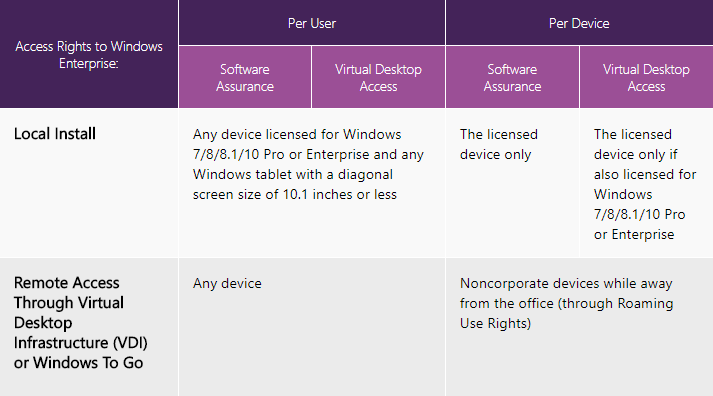Some thoughts about using Windows Server 2012 R2 instead of Windows 10 for VDI
Disclaimer: The information from this blog post is provided on an “AS IS” basis, without warranties, both express and implied.
Last week, I had an interesting discussion with a customer. Some months back, the customer has decided to kick-off a PoC for a VMware Horizon View based virtual desktop infrastructure (VDI). He is currently using fat-clients with Windows 8.1, and the new environment should run on Windows 10 Enterprise. Last week, we discussed the idea of using Windows Server 2012 R2 as desktop OS.
Horizon View with Windows Server as desktop OS?
My customer has planned to use VMware Horizon View. The latest release is VMware Horizon View 7.2. VMware KB article 2150295 (Supported Guest Operating Systems for Horizon Agent and Remote Experience) lists all supported (non-Windows 10) Microsoft operating systems for different Horizon VIew releases. This article shows, that Windows Server 2012 R2 (Standard and Datacenter) are both supported with all Horizon View releases, starting with Horizon View 7.0. The installation of a View Agent is supported, and you can create full- and linked-clone desktop pools. But there is also another important KB article: 2150305 (Feature Support Matrix for Horizon Agent). This article lists all available features, and whether they are compatible with a specific OS or not. According to this artice, the
- Windows Media MMR,
- VMware Client IP Transparency, and the
- Horizon Virtualization Pack for Skype for Business
are not supported with Windows Server 2012 R2 and 2016.
From the support perspective, it’s safe to use Windows Server 2012 R2, or 2016, as desktop OS for a VMware Horizon View based virtual desktop infrastructure.
Licensing
Licensing Microsoft Windows for VDI is PITA. It’s all about the virtual desktop access rights, that can be acquired on two different ways:
- Software Assurance (SA), or
- Windows Virtual Desktop Access (VDA)
SA and VDA are available per-user and per-device.

Patrick Terlisten/ vcloudnine.de/ Creative Commons CC0
You need a SA or a VDA for each accessing device or user. There is no need for additional licenses for your virtual desktops! You will get the right to install Windows 10 Enterprise on your virtual desktops. This includes the LTSB (Long Term Servicing Branch). LTSP offers updates without delivery of new features for the duration of mainstream support (5 years), and extended support (5 years). Another side effect is, that LTSB does not include most of the annoying Windows apps.
Do yourself a favor, and do not try to setup a VDI with Windows 10 Professional…
Service providers, that offer Desktop-as-a-Service (DaaS), are explicitly excluded from this licensing! They must license their stuff according to Microsofts Services Provider Licensing Agreement (SPLA).
How do I have to license Windows Server 2012 R2, if I want to use Windows Server as desktop OS? Windows Server datacenter licensing allows you to run an unlimited number of server VMs on your licensed hardware. To be clear: Windows Server is licensed per physical server, and there is nothing like license mobility! To license the access to the server, your need two different licenses:
- Windows Server CAL (device or user), and
- Remote Desktop Services (RDS) CAL (device or user)
The Windows Server CAL is needed for any access to a Microsoft Windows Server from a client, regardless what service is used (even for DHCP). The RDS CAL must be asssigned to any user or device, that is directly or indirectly interacting with the Windows Server desktop, or using a remote desktop access technology (RDS, PCoIP, Blast Extreme etc.) to access the Windows Server desktop.
With this license setup, you have licensed the Windows Server VM itself, and also the access to this VM. There is no need to purchase a SA or VDA.
Do the math
With this in mind, you have to do the math. Compare the licensing costs for Windows 10 and Windows Server 2012 R2/ 2016 in your specific situation. Setup a PoC to verify your requirements, and the support of your software on Windows Server.
Windows Server can be an interesting alternative compared to Windows 10. Maybe some of you, that already use it with Horizon View, have time to add some comments to this blog post. It would be nice to get some feedback about this topic.
